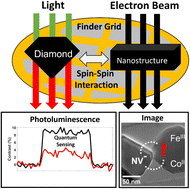Nitrogen vacancy defects in single-particle nanodiamonds sense paramagnetic transition metal spin noise from nanoparticles on a transmission electron microscopy grid†
Abstract
Spin-active nanomaterials play a vital role in current and upcoming quantum technologies, such as spintronics, data storage and computing. To advance the design and application of these materials, methods to link size, shape, structure, and chemical composition with functional magnetic properties at the nanoscale level are needed. In this work, we combine the power of two local probes, namely, Nitrogen Vacancy (NV) spin-active defects in diamond and an electron beam, within experimental platforms used in electron microscopy. Negatively charged NVs within fluorescent nanodiamond (FND) particles are used to sense the local paramagnetic environment of Rb0.5Co1.3[Fe(CN)6]·3.7H2O nanoparticles (NPs), a Prussian blue analogue (PBA), as a function of FND-PBA distance (order of 10 nm) and local PBA concentration. We demonstrate perturbation of NV spins by proximal electron spins of transition metals within NPs, as detected by changes in the photoluminescence (PL) of NVs. Workflows are reported and demonstrated that employ a Transmission Electron Microscope (TEM) finder grid to spatially correlate functional and structural features of the same unique NP studied using NV sensing, based on a combination of Optically Detected Magnetic Resonance (ODMR) and Magnetic Modulation (MM) of NV PL, within TEM imaging modalities. Significantly, spin–spin dipole interactions were detected between NVs in a single FND and paramagnetic metal centre spin fluctuations in NPs through a carbon film barrier of 13 nm thickness, evidenced by TEM tilt series imaging and Electron Energy-Loss Spectroscopy (EELS), opening new avenues to sense magnetic materials encapsulated in or between thin-layered nanostructures. The measurement strategies reported herein provide a pathway towards solid-state quantitative NV sensing with atomic-scale theoretical spatial resolution, critical to the development of quantum technologies, such as memory storage and molecular switching nanodevices.

- This article is part of the themed collection: Nanoscale quantum technologies


 Please wait while we load your content...
Please wait while we load your content...